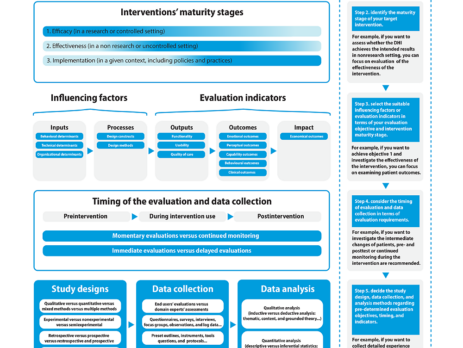We systematically reviewed the evaluation of digital patient experiences (digital PEx) in healthcare, focusing on when, what, and how to measure them. Drawing from 45 systematic reviews, we identified key timing considerations, evaluation indicators, and approaches. This study provides a structured guide for researchers, developers, and practitioners to improve digital PEx evaluations, ensuring these tools meet patient needs and healthcare objectives.
What was the context of our study?
Digital health interventions (DHIs) are transforming healthcare by offering innovative tools for patient care. However, evaluating their effectiveness and impact on patient experiences remains a challenge. Without robust evaluation methods, DHIs risk low adoption, poor user satisfaction, or limited clinical integration. Our study aimed to address these gaps by defining evaluation standards for digital PEx.
What did we do?
We conducted an umbrella review of 45 systematic reviews, analyzing how digital PEx is evaluated across various studies. Using a thematic analysis approach, we categorized evaluation timing, indicators, and methods into distinct frameworks. Our analysis incorporated behavioral, technical, and organizational factors influencing digital PEx evaluations, ensuring a comprehensive perspective.
What did we find?
- Timing: Evaluations are most effective when aligned with the intervention’s lifecycle—during design, implementation, or post-intervention. Immediate feedback offers real-time insights, while long-term studies capture sustainability and impact.
- Indicators: Key metrics include usability, emotional and perceptual outcomes, patient adherence, and healthcare system impact. Themes such as functionality, accessibility, and economic outcomes emerged as critical factors.
- Methods: A mix of qualitative and quantitative approaches, including interviews, surveys, usability testing, and longitudinal studies, provides robust insights. Incorporating theoretical frameworks enhances the validity and applicability of evaluation findings.
Why is this important?
Effective evaluation of digital PEx ensures that DHIs meet patient expectations, improve healthcare delivery, and enhance overall outcomes. Our findings offer actionable insights for designing and assessing digital health tools, enabling better integration into healthcare systems and increasing patient trust and engagement.
Reference
Wang T, Giunti G, Goossens R, Melles M. Timing, Indicators, and Approaches to Digital Patient Experience Evaluation: Umbrella Systematic Review. J Med Internet Res. 2024;26:e46308. https://doi.org/10.2196/46308.

